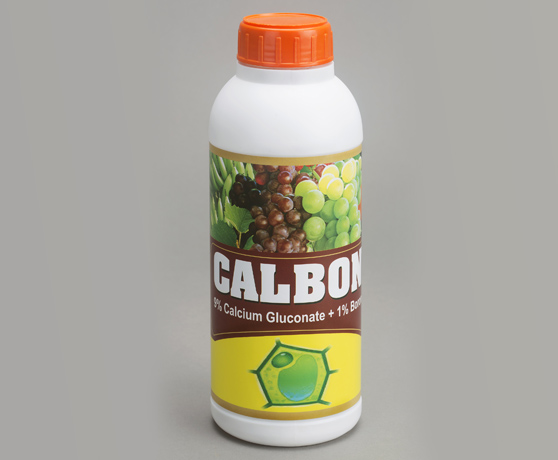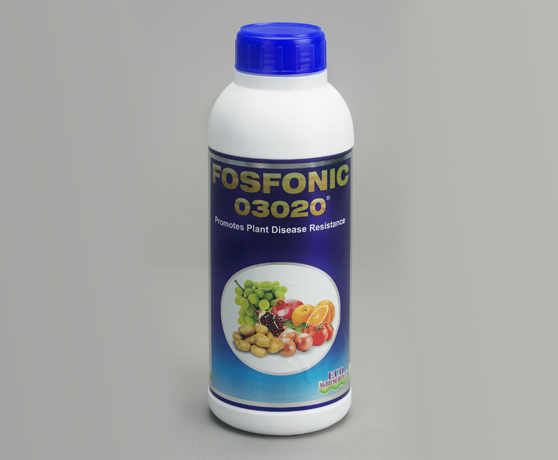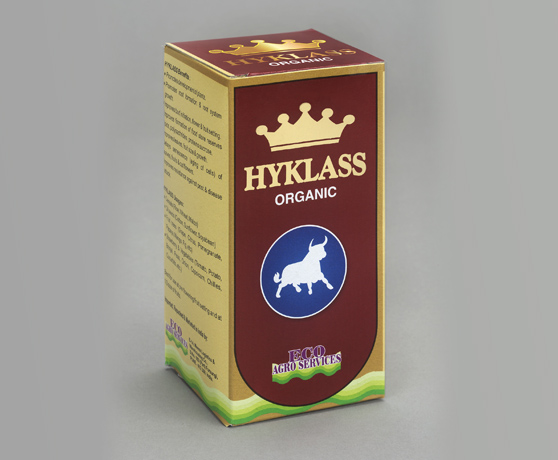


-
INTRODUCTION
1. Natural chelating agent therefore high acceptance by plants.
2. Quick absorption & delivery of Calcium to tissues where it is required.
MORE DETAILS
- Water Soluble Calcium (CaO):- 9%; Water Soluble Boron:- 1%.
- Chelating Agent- Heptagluconic Acid: 100%
- Colour: Light Brown
- pH: 2.3
- Density: 1.3 g/cc
- Free from chloride, sulfate, and nitrate.
- It is immobile & remains in older tissue.
- Calcium is a primary constituent of cell walls & membranes and is involved in production of new growing parts & root tips.
- Deficiency of Calcium will adversely affect cell division; impair structural stability & permeability of cell walls.
- Increase of Calcium in Fruit, promotes longer storage life & resists a range of Physiological breakdown conditions (such as water core, Bitter pit, internal browning in Apples, Tip burn in Lettuce, Internal Rust spots in Potatoes & Blossom End Rot in Tomatoes, Bud Necrosis in Grapes) etc.
- Due to stronger cell walls provided to the plant by Calcium, Fungal spores are less likely to penetrate and germinate in host cells.
- Crops that suffer from diseases like Botrytis, Rhizoctonia, Phythium, & Fusarium can have greater resistance to such fungal attacks
- Excessive dry or wet soils
- Excessive Potash in soils
- Upper leaves are distorted & curled at edges
- Leaves may have yellow bands
- Leaves may turn brown & die.
- Roots develop poorly , are short & chubby and turn brown at an early age and have few root hairs
- The leaves of some plants hook downward and exhibit marginal necrosis
- In blossom end rot, pale brown sunken areas will develop around blossom end. (e.g. Tomatoes).
- Flower buds will fail to develop
- In case of Grapes. Calcium deficiency creates bud Necrosis in Grape bunch
- Slow root development. Roots may develop a dark color and in severe cases the growing point may die.
- New leaf growth may slow and leaf tips may stick together. Remember that calcium does not readily translocate within the plant. So deficiency symptoms will appear on the new growth.
- Poor nodulation by nitrogen fixing bacteria on leguminous plant roots. Ineffective nodules are white to grayish green inside while healthy nodules have dark pink interiors.
- Blossom end rot in tomatoes. Calcium and proper water management improve plant resistance to this problem.
- Aborted and shriveled fruit on peanuts. A shortage of calcium at "pegging" results in a high percentage of "pops".
- Darkened plumule or "black heart" in peanut seed. This reduces yield, quality and crop value.
- Pod rots diseases on peanuts. Pods are predisposed to fungus infections when calcium is deficient or out of balance with Mg and K.
| Crop | Recommendation | No of applications & timing |
|---|---|---|
| Apples | To Prevent Bitter pit | 5 applications beginning at petal fall |
| Grape | Improved fruit finish & storage | 5 applications from beginning of berry setting to maturity |
| Oranges | To increase fruit firmness | 2-3 applications |
| Strawberry | To increase fruit firmnesst | 3 applications |
| Cabbage Lettuce Cauliflower | To Prevent Tip burn | 2 –3 applications starting at head formation |
| Cucumber, Melons, Capsicum, Tomatoes | To Prevent Blossom end rot | 3-6 applications from flowering & in times of heat stress |
| Potatoes | To Prevent Internal brown spot | 3-6 applications from flowering & in times of heat stress |
| Apples | To Prevent Bitter pit | 5 applications beginning at petal fall |
| Onion | To Prevent Tip burn. To obtain Larger Onions with better storability | 6 leaf stage onward 2-4 sprays |
| Vegetables | To get crisp and firm vegetables with shiny appearance | 2 sprays at flowering to fruiting |
| Groundnut | To improve quality & yield | 2-3 sprays beginning pegging |
| Leafy vegetables | For freshness and shiny appearance | 1 spray 8-10 days before harvest |
| Ornamentals | To increase Vase life | Weekly application with Pesticides |
- It is free from Chloride, Sulfate and Nitrogen, and therefore ideal for crops during fruiting, Flowering & in periods during maturity
- Ideally applied as a foliar fertilizer, CALBON is directly absorbed by leaves, Shoots and fruits.
- CALBON will also have a favorable effect in reducing sun damage.
2 ml/Liter for foliar application.
- Not for Human / Medicinal use
- Keep away from Eyes & Skin


